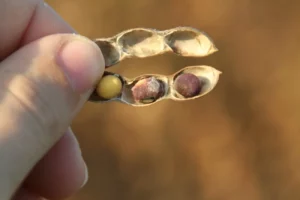Harvest and delivery delays this fall can be blamed partly on the weather and partly on the continued impact of Hurricane Ida on grain movement through the system. I have received a number of calls from agents and growers concerning soybean discounts taken at delivery, with questions about how to prevent specific discounts in the future.
There is some flexibility depending on the grain buyer, but USDA soybean seed grade factors are based on a sample having a specific test weight range, and less than maximum allowable percentage of splits, damaged seed, foreign matter and other special discount factors such as ‘Purple Mottling and Stain’.
Moisture Content– Moisture content is not a quality grading factor, but a discount is applied to cover the cost to dry seed to lower moisture. Field dry-down has been slowed from intermittent cool and wet weather in September and in October keeping seed moisture steady or slow to drop. The longer mature beans are left in the field, the more seed ‘weather’ and late season disease can impact seed quality. This has been an unusual fall, because some grain buyers have been turning away soybeans above 14% moisture, in part due to barge back up and the general slowdown of grain movement through channels. Without on-farm drying and storage, there isn’t much we can do to work around moisture content. Try to harvest as soon as moisture hits desired level. On the plus side, by harvesting more of our crop at 13% or higher moisture, producers should be seeing less split seed.
Test Weight- Soybean test weight doesn’t get a lot of attention, but there are some reports of low test weight discounts this fall. Test weight is basically a measure of seed density and is inversely related to seed moisture but directly related to quality. Good quality seed of low moisture content can be expected to have a good test weight. Soybean seeds with lower test weight typically have quality issues (shriveled or damaged seed) and may not store well. U.S. No. 1 Grade soybeans must have a test weight of 56 and higher (along with having other quality limits for splits, damaged seed, etc.). U.S. No. 2 Grade soybeans must have a test weight of at least 54. When test weight drops below 54 (or below 52 for some buyers), a discount may be taken. Test weight is linked to genetics and environment. Timely fungicide application to control seed diseases and prompt harvest may help ensure better quality and therefore test weight.
Purple Mottled or Stained seed– I have had several calls about this one, especially from Middle Tennessee. Soybean samples with 2% or more purpled/discolored seed (where at least 50% of seed surface is discolored) are considered to be “Purple Mottled or Stained” and may be discounted. Purple seed at harvest, is an indicator that Cercospora Leaf Blight (CLB) was probably present in the field. While this disease typically does not affect yield, it can affect seed quality when severe enough. CLB is caused by the fungus Cercospora kikuchii which overwinters on old residue or infected seed. Infected plants display purpling or bronzing on leaves, usually observed later in the season. Under the right conditions, the fungus may also infect seeds resulting in either no symptomology or purple discoloration on some part of the seed. Plants that exhibit leaf symptoms do not necessarily produce stained seed unless conditions are favorable. Crop rotation, planting pathogen free seed and planting more tolerant varieties can reduce amount of disease. Fungicides may help lessen severity of leaf and seed infection, although no active ingredient is 100% effective against CLB. Heather Kelly has listed some options for CLB in the soybean foliar fungicide efficacy chart. Products that contain the active ingredients flutriafol, tetraconazole, difenoconazole, or cyproconazole are rated as Poor to Good or Fair but are the better choices. In fields with known history of CLB and seed stain, application should be made during pod development (R3-R4). In fields with known history of late season disease and seed quality issues, consider an R5 application to improve seed quality.


